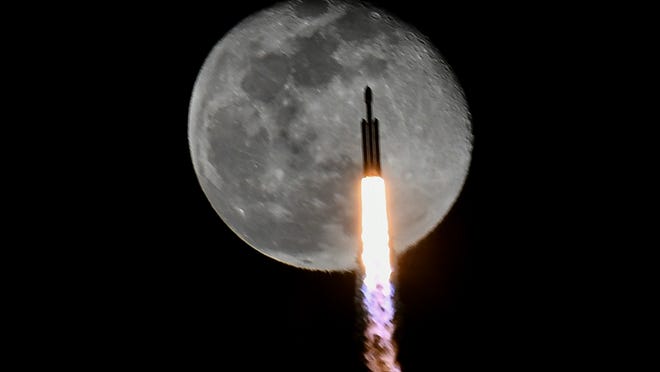It’s time to bring out the big engines. Those on the Space Coast will soon be in for a treat.
Not one, but three Falcon 9 first-stage rockets, which make up the Falcon Heavy, will tentatively blast into the Florida sky this week to launch a weather satellite into orbit.
It’s been a while since Florida has seen this spectacle: two Falcon 9s supporting the main rocket and carrying the second stage and payload into space. Falcon Heavy last took to the Florida skies from Pad 39A at the Kennedy Space Center in late December, carrying the secret Space Force spaceplane known as X-37B. The only other comparable launch since then was the triple-core ULA Delta IV Heavy final, which carried a payload for the National Reconnaissance Office from Cape Canaveral in April.
Why is Falcon Heavy needed for this launch?
A bigger payload requires more power, and with NOAA and NASA set to launch the GOES-U weather satellite as soon as Tuesday, June 25, they needed a bigger rocket. The satellite is comparable in size to a small school bus, so it will use one of the heaviest lift rockets. Enter the Falcon Heavy.
When is the next launch in Florida?Is there a launch today? Upcoming rocket launch schedule from SpaceX, NASA and ULA in Florida
SpaceX Space Coast Rockets: Falcon Heavy vs. Falcon 9
Simply put, the Falcon Heavy consists of three Falcon 9 rocket first stages – which together provide three times the lift. The middle Falcon 9 is fully loaded with the rocket’s second stage and payload on top. The payload, in this case the NOAA satellite, is encased in fairings to protect it on its way to space.
By comparison, the Falcon 9 that launches Starlink missions is a single rocket. Only one of these single rockets with the second stage is 70 meters high and has a diameter of 3.5 meters.
With three of these Falcon 9 rockets, the monster Falcon Heavy is at the same height. However, it is much wider, giving it a width of 11 meters, which is comparable to almost three cars parked bumper to bumper.

According to SpaceX, the Falcon Heavy has performed nine launches, 17 booster landings and 14 booster relights.
The first successful Falcon Heavy took to the skies in February 2018, carrying a red Tesla Roadster, along with a mannequin named ‘Starman’ – which was adorned with a SpaceX spacesuit.
Falcon Heavy Thrust: How powerful is this rocket?
Three Falcon 9 rockets – each with nine Merlin engines – will give the Falcon Heavy vehicle the power of 27 Merlin engines at launch. Each of these 27 engines delivers 190,000 lbs of thrust. According to SpaceX, this force produces a total of more than five million pounds of thrust.
SpaceX says the Falcon Heavy can lift weight comparable to that of a 737 jetliner, along with all its fuel, cargo and passengers, and get that weight into orbit.
Space X Falcon Heavy booster landing
SpaceX will restore the two supporting Falcon 9 boosters. Following the procedure of previous flights, the two boosters will land at the Cape Canaveral landing site, emitting a double wave of sound. Should SpaceX continue the routine of previous Falcon Heavy flights, the core Falcon 9 will disintegrate over the ocean after it completes its task.
Landing all three boosters has proven to be a difficult task. While a nuclear booster landed on a drone ship in the Atlantic Ocean in 2019, SpaceX failed to return it to port.
Get ready for Falcon Heavy sonic booms
As the two support boosters land at SpaceX Landing Sites 1 and 2 on the coast of Cape Canaveral, two sonic booms will be heard on the Space Coast. As the boosters fall back to Earth, they travel faster than the speed of sound. This in turn breaks the sound barrier and emits a sound similar to loud thunder.
The sonic booms will come while the boosters are already landing, which may seem puzzling. Physics explains this situation simply because light travels faster than sound. The returning boosters will be seen before the sonic booms are heard.
It can be a surprising sight, especially if you’ve never witnessed it before: the boosters appear to land silently before a loud, earth-shaking sound is heard.
When will SpaceX Falcon Heavy launch?
Space Coast weather permitting, the Falcon Heavy will lift off Tuesday from Pad 39A at the Kennedy Space Center and carry the NOAA/NASA GOES-U satellite into orbit.
GOES-U is NOAA’s newest weather satellite, promising continuous hurricane tracking. Weather observation satellites, such as the GOES series, are important for locations where these extreme weather events occur – such as Florida.

GOES-U will provide valuable top-down observation, observing hurricanes as they form. “We know about them because of the GOES satellites. They sit above the equator, about 22,000 miles above the Earth, and we’re constantly monitoring them,” Dan Lindsey, a NOAA program scientist, told FLORIDA TODAY.
Be sure to follow the FLORIDA TODAY Space Team for the latest updates from the Space Coast.
Brooke Edwards is a space reporter for Florida Today. Contact her at bedwards@floridatoday.com or at X: @brookeofstars.
